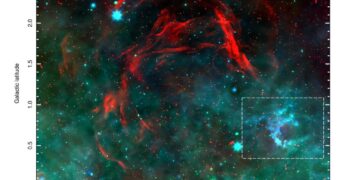Astronomers have uncovered a stellar marvel closer to Earth than initially thought. The Galactic supernova remnant G278.94+1.35, affectionately nicknamed “Diprotodon,” has captivated scientists with its revised proximity and fascinating properties. Originally discovered in 1988, this remnant has been reanalyzed using cutting-edge technology, revealing new insights about its size, distance, and characteristics.
What is G278.94+1.35?
G278.94+1.35 is no ordinary celestial object—it is a supernova remnant (SNR), the diffuse and expanding structure left behind after a massive star’s explosive demise. These remnants contain material ejected from the supernova and interstellar matter swept up by the shockwave. Initially estimated to be 8,800 light-years away and spanning about 320 light-years, this remnant was considered one of the larger SNRs in our galaxy. However, recent observations have dramatically revised these figures.
Supernova remnants like Diprotodon are crucial to our understanding of the universe. They act as natural laboratories for studying the life cycles of stars, the distribution of heavy elements, and the dynamics of the interstellar medium. By examining G278.94+1.35, astronomers can trace the history of its progenitor star and the energy released during its explosive end.
New Findings from the ASKAP Observations
The recent breakthrough came courtesy of the Australian Square Kilometer Array Pathfinder (ASKAP) as part of the ASKAP-Evolutionary Map of the Universe (EMU) project. This advanced telescope system provided astronomers with high-resolution images that redefined our understanding of Diprotodon’s size and distance. Originally believed to be 8,800 light-years away, the remnant is now estimated to lie only 3,300 light-years from Earth—less than half the original estimate.
This closer distance has implications for its physical dimensions. ASKAP data show that Diprotodon’s diameter is approximately 189 x 182 light-years, much smaller than previously thought. Despite its reduced size, its nearly circular shape and ongoing expansion highlight its dynamic nature.
A Cultural and Scientific Namesake
In a creative nod to Australia’s prehistoric past, scientists have named the remnant “Diprotodon” after an extinct genus of massive marsupials that once roamed the continent. These wombat-like creatures symbolize the size and uniqueness of this SNR, drawing a fascinating connection between Earth’s history and the cosmos.
The name also serves a broader purpose: raising awareness of the extinction crisis faced by many species today. By naming G278.94+1.35 after a vanished animal, scientists aim to draw attention to the need for conservation while celebrating the discovery of one of the galaxy’s largest known remnants.
Why This Discovery Matters
The revised measurements and analysis of Diprotodon carry significant scientific implications. By studying the remnant, astronomers can gain insights into the life cycle of its progenitor star, estimated to have been 15 times the mass of our Sun. The energy released in the supernova—approximately 500 quindecillion erg—offers a glimpse into the immense forces at play during such cataclysmic events.
Moreover, the study of Diprotodon’s spectral index, measured at -0.55, confirms its classification as a typical shell-type SNR. This information helps scientists refine their models of how these remnants evolve over time and interact with their surroundings.
Impacts on Astrophysical Research
The discovery of Diprotodon closer than expected underscores the importance of accurate measurements in astronomy. Such findings not only enhance our understanding of individual objects but also have broader implications for galactic studies. By accurately modeling the size, distance, and expansion of supernova remnants, researchers can better understand the distribution of elements in the Milky Way and the dynamics of the interstellar medium.
Diprotodon also serves as a benchmark for studying other SNRs. Its relatively young age—around 1 million years—makes it an excellent candidate for understanding the early stages of SNR evolution. Additionally, its location and shape provide clues about the environment in which it formed, shedding light on the conditions that lead to such massive explosions.
Conclusion
The discovery of G278.94+1.35, or Diprotodon, represents a milestone in our exploration of the cosmos. From its revised proximity to its rich scientific and cultural significance, this supernova remnant offers a treasure trove of knowledge about the life and death of stars. Its study not only deepens our understanding of the universe but also serves as a reminder of the interconnectedness of science, history, and culture.
Reference:



















